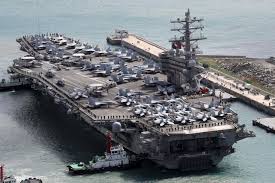The USS Theodore Roosevelt, a nuclear-powered U.S. aircraft carrier, arrived in Busan, South Korea, on Saturday, marking a significant show of force against an increasingly belligerent North Korea. This deployment comes in the wake of a controversial security pact between North Korea and Russia, further escalating tensions in the region.

The carrier’s arrival coincides with the planned Freedom Edge drills, a trilateral exercise involving the United States, South Korea, and Japan. These military maneuvers announced earlier in June following a meeting of defense chiefs in Singapore, are designed to enhance tactical proficiency and improve interoperability among the allied navies.
Rear Admiral Christopher Alexander, commander of Carrier Strike Group Nine, emphasized the exercise’s importance in ensuring readiness “to respond to any crisis and contingency.” The South Korean navy echoed this sentiment, stating that the carrier’s presence demonstrates the allies’ “stern willingness to respond to advancing North Korean threats.”

This naval deployment is part of a broader strategy by the United States and its allies to counter North Korea’s growing nuclear and missile capabilities. It follows the visit of another U.S. carrier, the USS Carl Vinson, to South Korea seven months ago, underscoring the United States’ commitment to regional security.
The timing of the Roosevelt’s arrival is particularly significant, coming just a day after South Korea summoned the Russian ambassador to protest a defense agreement between Russian President Vladimir Putin and North Korean leader Kim Jong Un. This pact, which promises mutual defense assistance in case of war, has been viewed by South Korea as a direct threat to its security.
In response to this development, South Korea has hinted at the possibility of sending arms to Ukraine to support its fight against Russian invasion – a move that would likely severely strain Seoul-Moscow relations.

The intensifying situation has led to increased military cooperation between the United States, South Korea, and Japan. These nations have not only expanded their combined training exercises but have also been working on updating their nuclear deterrence strategies. South Korea, in particular, is seeking stronger assurances from the United States regarding the use of its nuclear capabilities in defense of its ally.
As the Roosevelt strike group prepares for the upcoming Freedom Edge drills, the international community watches closely. This naval exercise, along with the broader military posturing in the region, serves as a clear message to North Korea and its allies about the resolve of the U.S.-led alliance in maintaining peace and stability in Northeast Asia.
The unfolding events highlight the complex geopolitical landscape of the Korean Peninsula and surrounding regions, where military preparedness, diplomatic relations, and nuclear deterrence strategies continue to play crucial roles in shaping regional security dynamics.
AP



